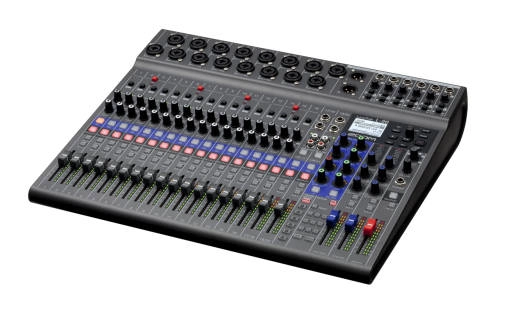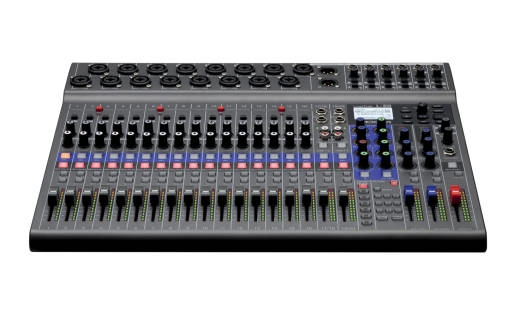Zoom LiveTrak L-20 Digital Recording/Mixing Console

Additional Photos:
Great Additions
Description
The LiveTrak L-20 is the new digital console offering everything creators need to mix, monitor, and record complex productions. With 20 discrete audio channels and six individual custom monitor mixes, it's built for bigger, bolder arrangements.
The LiveTrak L-20 is designed to mix bigger. It features 20 inputs (16 mono mic/line inputs and two stereo inputs), all with independent 3-band mid-parametric EQ. The 16 mono inputs offer stand-alone compressor control. Record 20 discrete channels plus a stereo mix directly to an SD card. The LiveTrak L-20 captures pristine audio in resolutions up to 24-bit/96 kHz. At -128 dBu EIN with +60 dB maximum input gain, the L-20 is equipped with our quietest and most advanced preamps ever. Mix down finished songs on the L-20 or transfer your discrete tracks to a DAW to perfect later.
With six independent monitor outputs for musicians, each output can have its own custom mix, complete with effects, that can easily be switched from a powerful headphone output, to a balanced line output for stage monitors. The LiveTrak L-20 features a dedicated 7th output for the FOH engineer. The sound engineer can monitor the main mix and any of the sub mixes, thus adjusting them to the musicians' satisfaction.
Although the LiveTrak L-20 is designed to work as a stand-alone recording and mixing console, it can also be used as a 22-in/4-out USB audio interface. Audio Interface mode lets you route inputs to any DAW or streaming software, even while recording to an SD card. Additionally, audio can be routed from your computer into the L-20 to be mixed with your live performance. Class compliant mode, which enables connection with iOS devices, is supported as well.
The LiveTrak L-20 also offers wireless control via a free iOS mobile app featuring most onboard functions, including Fader Levels and Modes, Scenes, EQ, EFX sends, returns, parameters, and more. You can even manage your Effects Library and Scene Library right from your device. Control it all on either large Monitor Out view with a mini transport, or a mini Monitor Out view with expanded Transport controls.
FEATURES:
• 20 discrete channels (16 mono plus 2 stereo) with XLR or -inch connectivity
• 22-track simultaneous recording, 20-track playback
• 22-in/4-out USB audio interface connectivity
• Records up to 24bit/96kHz audio to SD card
• 48V phantom power
• Hi-Z connectivity (channels 1-2)
• 26dB pad (channels 3-16)
• Built-in compression control (Channels 1-16)
• Solo buttons for individual channels
• Variable frequency low-cut control
• Main outputs plus 6 customizable monitor outputs
• Dedicated headphone output for sound engineer
• Scene saving function, up to 9 scenes saved at a time
• 20 built-in chorus, delay and reverb effects with adjustable parameters
• Two effect busses
• Built-in slate mic
• Class-compliant mode (for iOS compatibility)
• Compatible with Remote Mixer app for iPad
• Automatic recording starting/stopping capability
• Pre-record function
• Import/export projects with USB 2.0 host port
• Compatible functions for ZOOM FS01 footswitch
• Automatic power-save function
IN THE BOX:
• LiveTrak L-20
• AD-19 AC Adapter
• USB 2.0 Cable
• Quick Guide
SPECS:
• Inputs: Mono (MIC/LINE): 16, Stereo (LINE): 2
• Output: MASTER OUT: 1, MONITOR OUT: 6, PHONES: 1
INPUTS 1-8:
• Mono (MIC/LINE): Type: XLR/TRS combo jacks (XLR: 2 HOT, TRS: TIP HOT)
• Input gain: PAD OFF: +16 - +60dB, PAD ON: - 10 - +34 dB, Hi-Z ON: +6 -+50 dB
• Input impedance: XLR: 3 kOhm
• TRS: 10 kOhm /1 M ohm (when Hi-Z ON)
• Maximum input level: PAD OFF: 0 dBu (at 0 dBFS), PAD ON: +26 dBu (at 0 dBFS)
• Phantom power: +48 V
STEREO (LINE):
• Type: TS phone/RCA pin (unbalanced) jacks, Maximum input level : +10 dBu
MASTER OUT:
• Type: XLR jacks (balanced)
• Maximum output level : +/- 14.5 dBu
• Output impedance: 100 ohms
MONITOR OUT A-F (with balanced output) connected to monitor speakers:
• Type: TRS phone jacks (balanced)
• Maximum output level: +/- 14.5 dBu
*Output impedance: 100 ohms
MONITOR OUT A-F (with unbalanced output) connected to headphones:
• Type: Standard stereo phone jacks
• Maximum output level: 42 mW + 42 mW at 60 ohms
• Output impedance: 100 ohms
PHONES:
• Type: Standard stereo phone jacks
• Maximum output level: 42 mW + 42 mW at 60 ohms
• Output impedance: 100 ohms
BUSES
• Master: 1
• Monitor: 6
• Send EFX: 2
CHANNEL STRIP
• Low Cut: 40-600 Hz, 12dB/OCT
• EQ: HIGH: 10 kHz, +/- 15 dB, shelving
• MID: 100 Hz - 8 kHz, +/- 15 dB, peaking
• LOW: 100 Hz, +/- 15 dB, shelving
LEVEL METERS
• Level segments: 12
SEND EFFECTS
• Effects: 20 types - EFX : Hall 1, (Reverb) Hall 2, (Reverb) Room 1, (Reverb) Plate, (Reverb) Church, (Reverb) DrumAmb, (Reverb) GateRev, (Reverb) Vocal 1, (Delay + Hall Reverb) Vocal 2, (Delay + Mono Reverb) Vocal 3, (Delay + Plate Reverb)
EFX 2: Hall 3, (Reverb) Room 2, (Reverb) Spring, (Reverb) Delay, (Delay) Analog, (Delay) P-P Dly, (Delay) Vocal 4, (Delay + Room Reverb) Chorus 1, (Stereo Chorus) Chorus 2, (Mono Chorus) Cho+Dly, (Chorus + Delay)
RECORDER
• Maximum simultaneous recording tracks: 22 at 44.1/48/96 kHz
• Maximum simultaneous playback tracks: 20
• Recording format: WAV 44.1/48/96 kHz, 16/24-bit, mono/stereo
• Recording media: 4 GB 32 GB SDHC cards (Class 10 or higher)
64 GB - 512 GB SDXC cards (Class 10 or higher)
AUDIO INTERFACE
• 44.1/48 kHz: Recording: 22 channels Playback: 4 channels
• Bit depth: 24-bit
• Interface: USB 2.0
SYSTEM REQUIREMENTS FOR AUDIO INTERFACE MODE
Windows:
• OS: Windows 7 SP1 or later / 8.1 / 10 (32bit/64bit)
• CPU: Intel Core i3 or faster
• USB: USB 3.0/USB 2.0
Mac:
• OS: Mac OS X 10.11 / 10.12 / 10.13
• CPU: Intel Core i3 or faster
• USB: USB 3.0/USB 2.0
iPhone/iPad:
• OS: iOS 9 / 10 / 11
USB HOST
• Class: USB 2.0 High Speed
OTHER
• Sampling frequency: 44.1/48/96 kHz
• Frequency characteristics: 44.1 kHz: -1.0 dB, 20 Hz - 20 kHz / 96 kHz: -3.0 dB, 20 Hz - 40 kHz
• Equivalent input noise: Actual measurements: -128dB EIN (IHF-A) at +60dB/150ohm input
• Display: LCD with backlight (12864 resolution)
• Power: AD-19 AC adapter (DC12V 2A)
• Power consumption: 24 W maximum
• External dimensions: 445 mm (W) 388.4 mm (D) 82.6 mm (H)
• Weight (main unit only): 3.71 kg
Q & A
- asked on Jun 30, 2025
- answered by GREG HACKETT, Toronto (Bloor St.), Ontario
Reviews
Well conceived mixer.
1 of 1 customers found this review helpful
Delighted so far
8 of 8 customers found this review helpful
Zoom LiveTrak L-20 Usage Experience
54 of 58 customers found this review helpful







